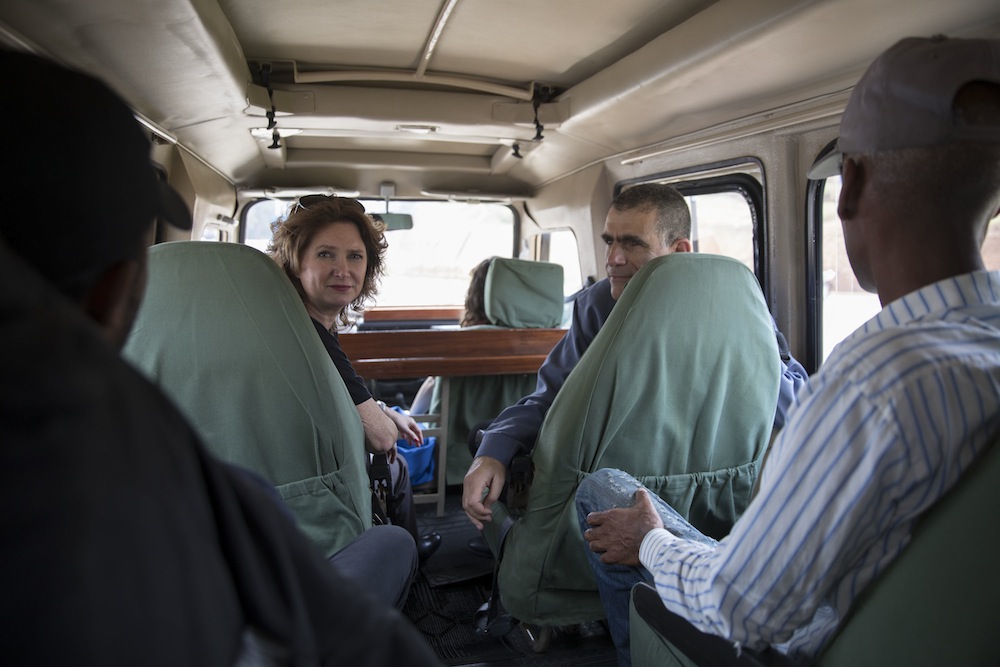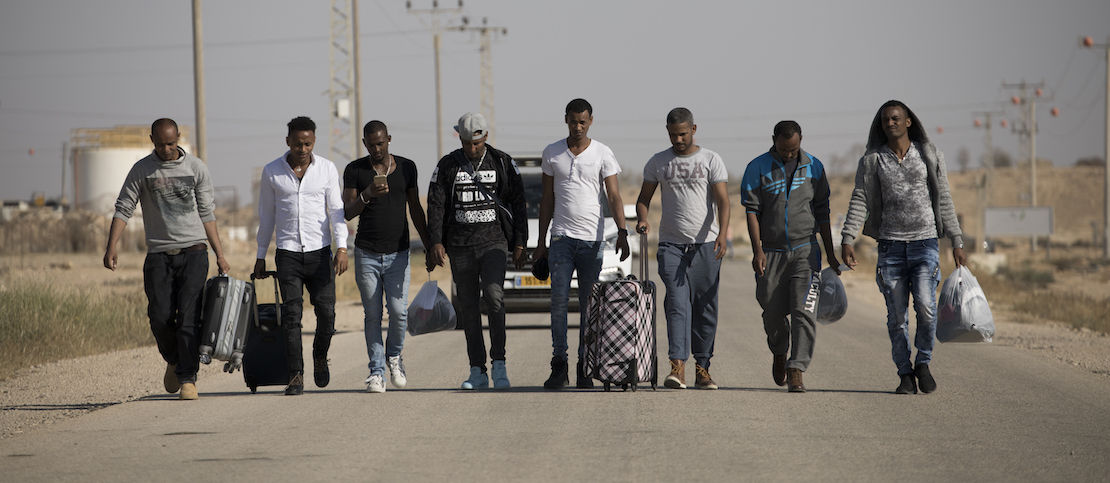The last year has been a tumultuous one for the 35,000 asylum seekers in Israel, most of whom have come from Sudan or Eritrea over the past decade. The Israeli government started the year with a plan to pay most of the asylum seekers to leave for Rwanda and Uganda, and with a half-cocked plan to forcibly deport the rest of them to those countries. Asylum seekers who refused deportation faced indefinite imprisonment. Meanwhile, the government refused to even examine the vast majority of their asylum requests.
“We live in a limbo” says Darfuri asylum seeker Jack Tigi-Tigi, 34, who arrived in Israel in 2008. “[For] more than 10 years people are waiting for an answer, but the state doesn’t want to check our cases to grant us [asylum] status.”
Tigi-Tigi says he has friends who managed to make it to Europe or the United States who received refugee status there after only a few months. “Israel wants to fight people emotionally and spiritually in order to break us down,” he laments. “When people are broken, they will leave on their own. They want to deport us indirectly.” Tigi-Tigi was for a time jailed in Holot, the desert detention facility Israel built four years ago to temporarily house asylum seekers. Many of his friends made the decision to leave after facing imprisonment.

Tigi-Tigi’s story is not exceptional among asylum seekers in Israel. Over the last 11 years, since the first group of Darfuri asylum seekers arrived through the Sinai peninsula from Egypt, Israeli authorities have refused to process the vast majority of their refugee status requests, leaving people in limbo, without status, and at risk of depression, poverty, and with no prospect of a future.
As the deportation plans ramped up early this year, asylum seekers and Israeli activists began to organize a grassroots campaign to stop the deportations, including through vigils, protests, street art, and international pressure. Protests were held outside Ugandan and Rwandan embassies around the globe, hoping to push those countries to back out of the deals they had allegedly struck with Israel.
Meanwhile, the Israeli government sought to fan the flames between the Jewish Israeli residents of south Tel Aviv and the asylum seekers who live there. “Over the past year, we saw how the right drew up an equation that put local residents on one side and asylum seekers on the other,” says Shula Keshet, director of the south Tel Aviv-based Mizrahi-feminist organization Ahoti, and who was recently elected to the Tel Aviv City Council. “This was done in an attempt to pit communities against one another.”
Instead, Keshet helped run the “South Tel Aviv Against the Deportation” campaign, which brought together asylum seekers and Israeli residents of south Tel Aviv, long one of the city’s most vulnerable areas.

“The last few years were difficult,” says activist Sigal Avivi. “The only good thing we managed to do was stop the deportations by putting pressure on foreign governments and parliament members in Rwanda and Uganda.” The mobilization of tens of thousands of Israelis to protest against the deportation was also a major accomplishment, she adds. “This is the first time the Israel public joined in masses to protest against it.”
In March a group of Israeli activists, including Avivi, petitioned Israel’s High Court of Justice against the planned deportations to Rwanda and Uganda. Ultimately, the court froze the plan after concluding that it would not likely stand judicial scrutiny.
A few weeks earlier, a group of Meretz MKs had traveled to Rwanda and Uganda to research the conditions that asylum seekers who had already been deported from Israel were living under. “One of the reasons we to Uganda and Rwanda was to stop the government’s policy of sending people to those countries,” says MK Mossi Raz, who was part of the delegation. Several days after the visit, the Rwandan government publicly announced that it would not accept refugees sent from Israel.
“We traveled to Rwanda and saw that all the asylum seekers deported there moved to Uganda shortly after arriving. We tried to understand what they were doing there and whether they received asylum status,” says Raz. What they found is that upon arrival in the Rwanda and Uganda, the asylum seekers were not given any legal status. Many went on to attempt the treacherous journey to Europe, with some drowning while trying to cross the Mediterranean.

+972 Magazine was one of the few to report from the ground in Rwanda and Uganda at the time, exposing the issues asylum seekers faced after being deported from Israel.
The dramatic turnaround came in April, when Netanyahu and his interior minister, Aryeh Deri, announced that the deportation plan had collapsed. “The court in effect forbade us from sending them to a country that wasn’t willing to accept them against their will,” Netanyahu said. “I searched for and I found a country that would agree to accept these people without them agreeing to go there. That was a very important breakthrough. We were very hopeful. We started to send these people, but very quickly, it became clear that this third country wasn’t holding up its end, that it wasn’t able to stand the pressure.”
Surprising almost everyone, in the same breath Netanyahu also announced that he had reached an historic agreement with the UN that would resettle 50 percent of the asylum seekers in Israel in Western countries. The rest would be allowed to remain in Israel, where they would receive asylum status. There were celebrations in the streets.
Yet just days after the initial announcement, following pressure from far-right activists and politicians, Netanyahu backed out of the agreement. The deportations were still not happening, but the tens of thousands of asylum seekers in Israel were back to an uncertain future without any proper legal status in the country.
“The community is in bad condition, especially psychologically,” Avivi says. “People are burned out and exhausted from the daily struggle to survive.”
Other activists and asylum seekers I spoke to are convinced the government will continue its efforts to make the life of asylum seekers in Israel unbearable. “I am sure we will see more attempts to make our life harder as the elections near,” says Atakliti Abraham, an asylum seeker and activist from Eritrea. “The government will try to show its voters that they are trying to push us out once again.”

Meanwhile, asylum seekers are still reeling from a law passed in May 2017 that forces them to deposit 20 percent of their wages into an escrow account that can only be accessed if and when they leave the country. The law also forces employers, mainly restaurants and hotels, to allocate another 16 percent of their wages into the fund. “I can’t even guess what the government will do next to make asylum seekers’ lives miserable,” says Sigal Rozen from the Hotline for Refugees and Migrants. “People can barely make a living and are trying to leave in any way they can.”
Of course, the government has found other ways to do just that, primarily by worsening the conditions at the Interior Ministry offices where asylum seekers are required to renew their temporary visas once a month.
Abraham, who spent most of 2018 organizing and taking parts in protests against the deportation, travels to the Interior Ministry in Bnei Brak before sunrise every morning to try and help asylum seekers lining up to renew their visas.
“Just this week we received notice that all asylum seekers will be sent to renew their visa in Bnei Brak, which will create huge lines.” A year since the deportation plan, Abraham laments that “we are back at the same spot.” It is clear to him that the visa renewal process and the deposit law are just the tip of the iceberg when it comes to Israel’s efforts to push asylum seekers out of the country.
Rozen says that despite the fact that the deportation was halted, asylum seekers are still looking for ways to leave, mainly to Canada and other Western countries, primarily through family reunification processes, joining relatives who have made it there.

And yet, there are also glimmers of hope. Near the end 2017, a group of Sudanese asylum seekers appealed to the Supreme Court to demand that authorities examine their asylum claims, which they had submitted years earlier. Before the appeal was even heard, the state granted temporary status to 800 asylum seekers from Darfur. During the hearing, held in October 2018, Israeli authorities announced they would begin — after a decade of refusing to do so — examining the individual asylum requests of Sudanese in Israel.
Meanwhile, following the murder of Silvana Tsegai, a 12-year-old asylum seeker in south Tel Aviv last month, the government finally funded a budget line item from 2016 to provide services to asylum seeker children. “There are thousands of children of asylum seekers who grow up in extreme poverty and unstable conditions — children who are left without basic rights,” says Orit Marom, the public awareness and advocacy director for ASSAF – Aid Organization for Refugees and Asylum Seekers in Israel. “We need to invest both in education and in social services.”
“There are only 40,000 asylum seekers in Israel, while the global refugee crisis is 70 million,” Marom adds. “The refugee case in Israel is a tool in right-wing governments’ political game. We are talking about a small group of people; if we integrate them they can be part of Israeli society within a few years.”


